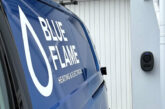
ABB’s Oliver Johnson answers a few questions on the opportunity charging stations at Birmingham Airport has ordered for a new all-electric bus service that will start operation in late 2019, and how this technology works.
What types of electric bus and charging technology has Birmingham Airport ordered?
Birmingham Airport has selected a fleet of six Volvo 7900e all-electric shuttle buses and two 300 kW opportunity charging pantographs at the airport terminal, as well as two 100 kW plug-in electric vehicle charging points with CCS2 connectors for vehicles in its lay-over bus/coach park.
Like many airports in the UK, it wanted to reduce emissions by replacing its fleet of diesel and petrol vehicles with all-electric vehicles.
The scheme has been designed to accommodate growth of local bus services. Additional pantographs may be installed at other locations on site in the future. In addition, the points at the terminal will be available to other operators.
How does opportunity charging work?
With opportunity charging, buses and other large vehicles receive charge from a pantograph system mounted on charging posts at the roadside.
When a bus approaches a stop at the terminal, a wireless communication link will confirm that charging may proceed safely and a pantograph will descend automatically, further safety checks are performed by the system before the charging starts.
Opportunity chargers are supplied as modular systems. For example ABB’s OppCharge is available in modules to provide power ratings of 150, 300 and 450 kW to suit the needs of the transport operator.
Birmingham Airport’s masts will deliver 300 kW of energy to the 200 kWh lithium-ion (Li-ion) batteries on board the Volvo 7900e. Because there is no need to plug in the buses, they can operate on a 24/7 basis without returning to the depot.
What standard does it follow?
The bus charging pantograph systems follows the standardisation which ABB have been a part of which covers all aspects of the electrical, communication, safety and connectivity of the solutions. Find more information on the OppCharge website at www.oppcharge.org.
The 100kW chargers follow the CCS standard that is maintained by the CharIn Association – www.charinev.org – which is also used by electric cars and commercial vehicles so there would be nothing stopping any other airport or commercial vehicle using the same set up.
How does the driver position the vehicle?
The driver has a window of +/- 300 mm so accurate positioning is crucial. To support the driver, the opportunity charging pantograph needs to be aligned with the front axel – a concept that is used widely in large vehicles to give drivers guidance. Small road bumps can also be introduced to aid the drivers.
Why did Birmingham Airport select this technology?
Speaking about the project, Andrew Duggins, Technical Services Director at Birmingham Airport, said: “This partnership is a key milestone for us. We have made significant customer service improvements across the Airport which will continue into 2019 with the aim of not only increasing capacity and improving passenger experience, but to also support with positioning Birmingham as Europe’s leading regional airport. These electric buses form part of this vision, not to mention their sustainability benefits, being completely emissions free.
“Volvo Bus and ABB met our requirements ensuring the charging products were cost effective while also being low emission. As part of the Airport’s Carbon Management Plan we are always investigating new and innovative ways to reduce our carbon emissions, so in working with Volvo Bus and ABB we will implement these ultra low emission buses that will work towards lowering our CO2 per passenger. By constantly looking at ways to reduce and directly influence our emissions since 2012 the Airport has reduced its CO2 per passenger from 2.18kg to 1.75kg per passenger.”
This article is the final feature in a three part series from ABB, which looks at the opportunities and technical challenges presented by the growing requirement for EV charging solutions. You can read Part 1 here, and Part 2 here.
For more details on ABB’s range of EV charging solutions, visit: https://new.abb.com/ev-charging
The video below, from Volvo Buses, offers more details about opportunity charging and the OppCharge system








